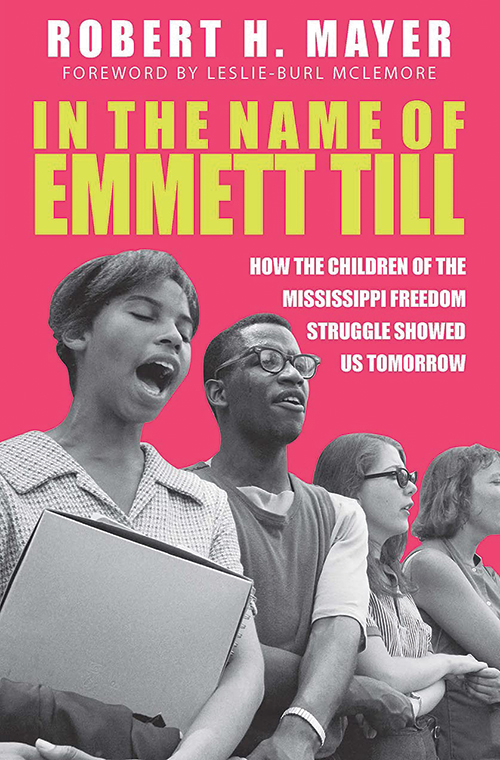
In the Name of Emmett Till: How the Children of the Mississippi Freedom Struggle Showed Us Tomorrow
Reviewed by Jerry Mizell Williams
May 1, 2022
By Robert H. Mayer. NewSouth Books, 2021. 224 pages. $19.95/hardcover; $12.95/eBook. Recommended for ages 12–18.
Unsung adolescent heroes of the Civil Rights Movement—who placed their life and liberty at risk to advocate for changes to unjust laws, codes, and practices—are the subject of this book. Young women and men who took “the core principles of American democracy to heart” and laid life and limb on the line share their story. Part of the query the author poses and answers is: Who speaks for young people, and how do they craft an individual and collective action-oriented path?
The book begins with an examination of the circumstances surrounding the murder of Emmett Till, sacrificed on the blood-soaked altar of the Jim Crow South. Till is posited as a youth icon, a tragic yet unforgettable symbol of a troubled, race-driven society in a nation at war with itself over Black and White identities and the legacy of slavery. Till’s 1955 lynching in Mississippi spoke to and galvanized Black teenagers during segregation. As background music, Billie Holiday’s “Strange Fruit” echoes through each chapter, a grim reminder of Southern trees from which hung the lynched bodies of Black women and men. Mayer describes the student activists as the “children of Medgar Evers,” whose career as a field secretary for the National Association for the Advancement of Colored People paved the way for the marches and protests. His assassination in 1963 served as the turning point for increased civil rights actions.
Where in the book the response of adult leaders or “the elders” is documented in the deeds of Evers, Rosa Parks, Ralph Abernathy, Ella Baker, Martin Luther King Jr., Fannie Lou Hamer, and others, it is the story of how leadership developed among adolescents. We follow the bold actions and incarceration of the Tougaloo Nine, college students who dared enter a Whites-only library to read; how Brenda Travis at age 15, in the shadow of Till, summoned up the courage to stage a school walkout and get arrested; the emergence of the North Jackson Youth Council’s boycott of the state fair and downtown stores; and the Woolworth’s lunch counter sit-in, which engendered the walkout of 500 students from Lanier High School. The picketing of J.C. Penney by several students and professors included Anne Moody, whose Coming of Age in Mississippi is a must-read about that era. These poignant stories are interlaced with the achievements of the Freedom Riders, the voter registration drive of Bob Moses, the rise of SNCC and CORE, and Freedom Summer.
Mayer shows the importance of recovering the voices of adolescents who mediated the complexities of segregation, voices that today form part of the written historical narrative of the civil rights struggle. The youth of Mississippi vividly articulate their own pain and growth. There are lessons to be discerned because the education of today’s youth about our nation’s past, argues Mayer, determines the future of tomorrow.
This is a well-crafted book that allows a critical chapter of the Civil Rights Movement to be re-interpreted against new facts and perspectives. Mayer addresses the inclusion of hate-filled language as being faithful to the socio-historical context in which it is to be understood. The subject matter ranges from slavery and rape to racism and lynching, yet the narrative is fluid especially when spoken by the youthful participants for the edification of their peers. I agree with the publisher’s recommended age range of ages 12–18 or grades 6–12. Amply illustrated with period photographs, the book incorporates useful notes, a bibliography, a list of abbreviations, a glossary, and an indispensable timeline of events from 1954–1965, the year in which the Voting Rights Act became law. This book is a reminder of our Quaker action past, present, and future.
Jerry Mizell Williams is a member of Green Street Meeting in Philadelphia, Pa. He is the author of numerous books, articles, and book reviews on colonial Latin America.


